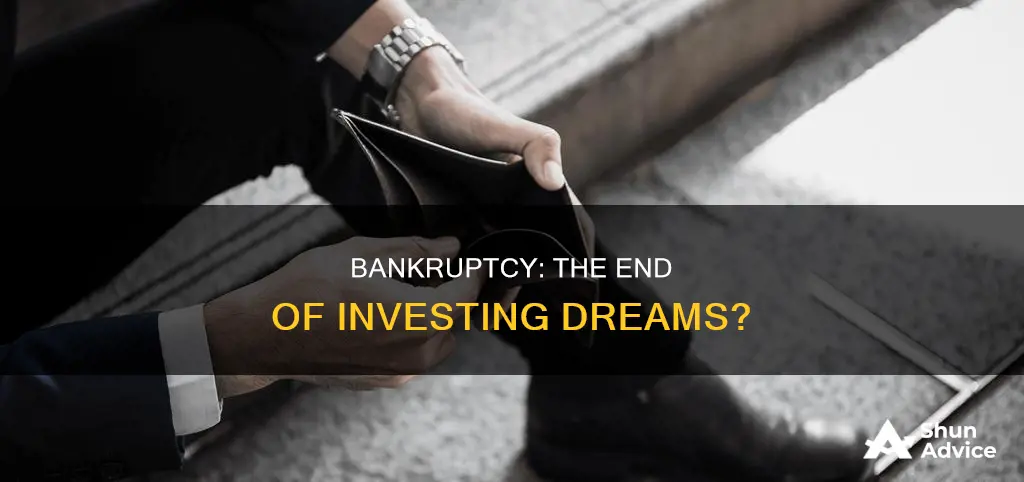
Bankruptcy is a legal process that allows companies or individuals to resolve their inability to pay their debts. It can be a negative situation for those involved, but it can also present opportunities for investors. When a company files for bankruptcy, its shareholders may be entitled to a portion of its assets, depending on the type of shares they hold. However, the stock itself usually becomes worthless, and shareholders are typically last in line for repayment.
There are two main types of bankruptcy for businesses: Chapter 11 and Chapter 7. Chapter 11 bankruptcy allows a company to reorganise and attempt to recover, while Chapter 7 bankruptcy leads to the company's closure and the liquidation of its assets. In both cases, shareholders often lose the value of their shares, but there is a greater chance of recovery under Chapter 11.
The impact of bankruptcy on investments also depends on the type of investment. Retirement plans like 401(k)s and certain types of IRAs are generally protected during bankruptcy proceedings, while other investments, such as stocks, stock options, and investment accounts, are typically not.
Overall, bankruptcy can have significant negative consequences for shareholders and investors, but it is important to assess each situation individually and seek expert advice when needed.
| Characteristics | Values |
|---|---|
| What happens to stock value? | In the case of Chapter 11 bankruptcy, the stock value may decrease but the company can recover. In the case of Chapter 7 bankruptcy, the stock value usually becomes worthless. |
| What happens to the company? | Chapter 11 bankruptcy means the company can reorganise and recover. Chapter 7 bankruptcy means the company has shut its doors for good. |
| What happens to shareholders? | Shareholders are last in line for repayment in the case of liquidation. In Chapter 11 bankruptcy, shareholders may receive new shares in the reorganised company, but these will be less valuable. In Chapter 7 bankruptcy, shareholders are unlikely to receive any money. |
| What happens to assets? | In Chapter 7 bankruptcy, a trustee is appointed to liquidate the company's assets and pay off its debt. In Chapter 11 bankruptcy, the company can reorganise its assets to recover. |
What You'll Learn
- Chapter 7 bankruptcy: a company ceases operations and a trustee sells its assets to pay creditors
- Chapter 11 bankruptcy: a company can reorganise and recover, but shares often become worthless
- Retirement accounts: some are protected in bankruptcy, but withdrawals lose federal protections
- Common stock: owners are last in line for repayment in liquidation
- Investment funds: a way to diversify your portfolio and reduce risk

Chapter 7 bankruptcy: a company ceases operations and a trustee sells its assets to pay creditors
Chapter 7 bankruptcy is a liquidation process where a company ceases operations and its assets are sold to pay off creditors. When a company files for Chapter 7, it means that the business is no longer viable and is unable to achieve profitability.
The process begins with the appointment of a trustee who takes control of the company's assets. The trustee's primary role is to maximize the value of the debtor's assets and ensure that creditors are paid. The trustee will sell the company's assets, and the proceeds are used to pay off the company's debts. This includes selling assets piecemeal or as a going concern.
The order in which creditors are paid is based on their status, with secured creditors being the first to receive payment, followed by unsecured creditors, and finally, stockholders. Secured creditors have the lowest risk as their loans are backed by collateral, and they will receive some payment even if the debtor declares bankruptcy. Unsecured creditors have a higher risk as they do not have a security interest in the debtor's assets, and they may only receive a pro-rata distribution of the assets. Stockholders have the highest risk and are last in line to receive any payment. They will only receive payment if the secured and unsecured creditors have been fully repaid.
It is important to note that Chapter 7 bankruptcy does not result in a discharge of debts for businesses. This means that the company's debts survive the liquidation process and will be charged against the corporation if it resumes operations.
The process of liquidating a company through Chapter 7 bankruptcy can be complex and lengthy, and it is designed to ensure that creditors receive payment for their debts. The process provides a framework for an orderly wind-down of the company's operations and the distribution of its assets to creditors.
Global Bargain Hunting
You may want to see also

Chapter 11 bankruptcy: a company can reorganise and recover, but shares often become worthless
Chapter 11 bankruptcy is a form of bankruptcy reorganisation available to individuals, corporations and partnerships. It is the usual choice for large businesses seeking to restructure their debt.
When a company files for Chapter 11 bankruptcy, it can continue normal day-to-day operations while ratifying a plan to reorganise its business and assets in such a way that will allow it to meet its financial obligations and eventually emerge from bankruptcy. Under Chapter 11, management runs the day-to-day business operations, but significant decisions are made by a bankruptcy court.
The bankruptcy court will confirm a Chapter 11 plan only when creditors are satisfied that they will receive at least as much as they would under a liquidation. The confirmed plan becomes a contract between the debtor and creditors, governing their rights and obligations.
During the bankruptcy process, a stockholder might choose to sell the stock or hold on to it in anticipation of a recovery. However, it is important to note that once bankruptcy is filed, stockholders will not receive previously scheduled dividend payments.
If a company operating under bankruptcy laws is delisted from major exchanges, it may continue to trade on the OTC Bulletin Board (OTCBB) or Pink Sheets. In this event, the stock symbol will be a five-letter ticker symbol that ends in "Q".
While bankruptcy can present an opportunity for investors to profit from a company's recovery, there are risks involved. These include old problems resurfacing and the presence of vulture investors, who buy stock during the bankruptcy process and sell it as soon as the company has re-emerged.
In many instances, the creditors and lenders will become the new owners, and the plan for reorganisation will effectively cancel the existing shares, making them worthless.
Strategic Retirement: Investing $2 Million for a Secure Future
You may want to see also

Retirement accounts: some are protected in bankruptcy, but withdrawals lose federal protections
Retirement accounts are treated differently depending on the type of bankruptcy filed. In Chapter 7 bankruptcy, most retirement plans and 401(k)s are exempt from liquidation, but there is a big caveat: the IRS. While creditors cannot access your 401(k) funds, the IRS can levy funds to pay your back taxes.
In the case of IRAs, there is a cap of $1.3 million (adjusted every three years for inflation) across all IRA assets. Any funds above this limit can be included in your bankruptcy estate to pay off debts. However, even exempted funds lose their protection if you are taking IRA withdrawals as income. Withdrawals from these plans automatically lose their federal protections, making them vulnerable during bankruptcy proceedings.
On the other hand, self-employed plans (SEPs) and SIMPLE IRAs are not included in the aggregate IRA limitation, meaning bankruptcy trustees cannot touch them regardless of the amount saved.
Chapter 13 bankruptcy allows individuals to keep their assets but requires them to pay their disposable income to creditors. This amount must be at least equal to the value of their non-exempt property.
In both Chapter 7 and Chapter 13 bankruptcies, it is crucial to determine how much equity you have in your real estate investments and whether your state offers a wildcard exemption to protect these assets. Consulting a local bankruptcy lawyer is advisable to navigate the complex rules and exemptions.
Retirement Investing: Why the Wait?
You may want to see also

Common stock: owners are last in line for repayment in liquidation
When a company files for bankruptcy, it means that it is in deep financial trouble and unable to pay its immediate obligations. There are two main types of bankruptcy recognised by US law: Chapter 7 and Chapter 11.
Chapter 7 bankruptcy means that the company has ceased operations and a trustee is tasked with selling any assets the company owns to repay creditors and investors. In this scenario, common stockholders are last in line for repayment and will likely receive nothing.
Chapter 11 bankruptcy allows a company to reorganise with the goal of becoming profitable again. The company continues day-to-day operations while developing a plan to renegotiate its debts and cut costs. Under Chapter 11, management runs the business under the oversight of a bankruptcy court. While common stockholders are still last in line for repayment, there is a chance the company will survive and the stock will retain some value.
During bankruptcy, stockholders face a difficult choice: hold on to their shares in the hope of a recovery, or cut their losses and attempt to sell. If the company in question files for Chapter 7 bankruptcy, the stock will likely become worthless and recovery of any investment is unlikely.
In the case of Chapter 11 bankruptcy, there is a greater chance that the company will survive and the stock will retain some value. However, as part of the reorganisation of debt, the company may cancel existing shares and issue new ones, leaving original shareholders with nothing.
In either scenario, common stockholders are last in line for repayment, following secured and unsecured creditors. Secured creditors have collateral backing their loans, while unsecured creditors do not. Unpaid wages and taxes are also prioritised over unsecured creditors.
Overall, while it is possible for a company to recover from bankruptcy and for stockholders to retain some value in their shares, common stockholders are generally last in line for repayment and often receive nothing.
Disney Stock: Buy or Bye?
You may want to see also

Investment funds: a way to diversify your portfolio and reduce risk
Diversification is a management strategy that blends different investments in a single portfolio. The idea behind diversification is that a variety of investments will yield a higher return and lower risk.
- Spread the Wealth: Don't put all your money in one stock or one sector. Consider investing in a handful of companies you know and trust, and even use in your day-to-day life. You can also invest in commodities, exchange-traded funds (ETFs), and real estate investment trusts (REITs).
- Consider Index or Bond Funds: Investing in securities that track various indexes makes a wonderful long-term diversification investment for your portfolio. By adding some fixed-income solutions, you are further hedging your portfolio against market volatility and uncertainty.
- Keep Building Your Portfolio: Add to your investments on a regular basis. If you have a substantial amount to invest, use dollar-cost averaging to smooth out the peaks and valleys created by market volatility.
- Know When to Get Out: Buying and holding, as well as dollar-cost averaging, are sound strategies. But don't ignore the forces at work. Stay current with your investments and any changes in overall market conditions.
- Keep an Eye on Commissions: Understand what you are getting for the fees you are paying. Some firms charge a monthly fee, while others charge transactional fees. Be aware of what you are paying and what you are getting for it.
It's important to note that bankruptcy is a negative situation that can have lasting effects on your investments. When a company declares bankruptcy, its stock value is at risk of going to zero. However, investors don't necessarily need to avoid investing in a company that has emerged from bankruptcy. These companies may offer good investment possibilities, but thorough research is crucial.
Investing in a diversified portfolio of investment funds can help reduce the impact of market volatility and lower the overall risk of your portfolio.
Fitness Investment: What's the Priority?
You may want to see also
Frequently asked questions
It depends on the type of bankruptcy the company files for. If it's Chapter 11 bankruptcy, there's a small chance your shares survive, but if it's Chapter 7 bankruptcy, your shares are most likely worthless.
Diversification is key. It's important to have a diversified portfolio so you're not overly reliant on any single company. A good rule of thumb is to have at least 25 to 30 companies in your portfolio to reduce risk.
Yes, there can be. For investors who are willing to do some research, bankruptcy can present opportunities. In some cases, companies that have emerged from bankruptcy offer good investment possibilities.







